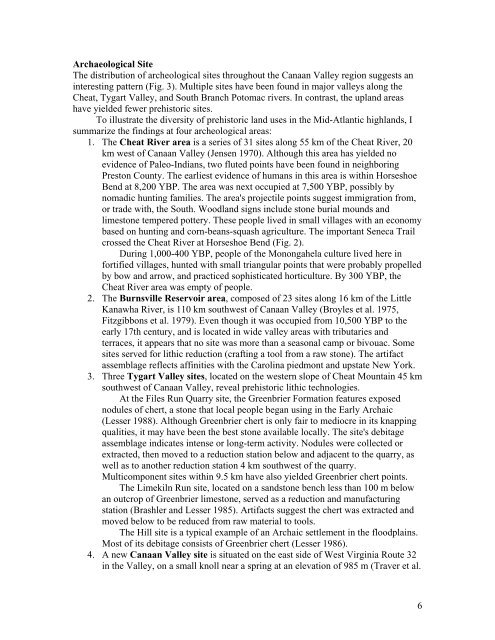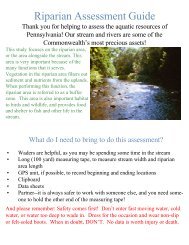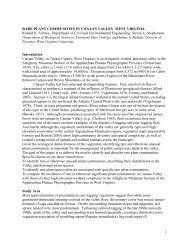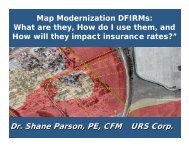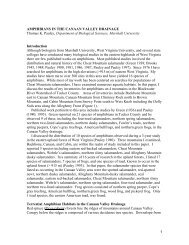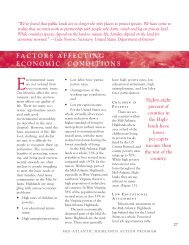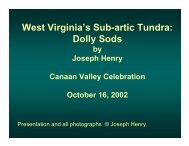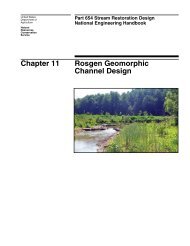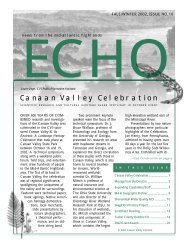1 PREHISTORY OF CANAAN VALLEY: AN ECOLOGICAL VIEW ...
1 PREHISTORY OF CANAAN VALLEY: AN ECOLOGICAL VIEW ...
1 PREHISTORY OF CANAAN VALLEY: AN ECOLOGICAL VIEW ...
You also want an ePaper? Increase the reach of your titles
YUMPU automatically turns print PDFs into web optimized ePapers that Google loves.
Archaeological Site<br />
The distribution of archeological sites throughout the Canaan Valley region suggests an<br />
interesting pattern (Fig. 3). Multiple sites have been found in major valleys along the<br />
Cheat, Tygart Valley, and South Branch Potomac rivers. In contrast, the upland areas<br />
have yielded fewer prehistoric sites.<br />
To illustrate the diversity of prehistoric land uses in the Mid-Atlantic highlands, I<br />
summarize the findings at four archeological areas:<br />
1. The Cheat River area is a series of 31 sites along 55 km of the Cheat River, 20<br />
km west of Canaan Valley (Jensen 1970). Although this area has yielded no<br />
evidence of Paleo-Indians, two fluted points have been found in neighboring<br />
Preston County. The earliest evidence of humans in this area is within Horseshoe<br />
Bend at 8,200 YBP. The area was next occupied at 7,500 YBP, possibly by<br />
nomadic hunting families. The area's projectile points suggest immigration from,<br />
or trade with, the South. Woodland signs include stone burial mounds and<br />
limestone tempered pottery. These people lived in small villages with an economy<br />
based on hunting and corn-beans-squash agriculture. The important Seneca Trail<br />
crossed the Cheat River at Horseshoe Bend (Fig. 2).<br />
During 1,000-400 YBP, people of the Monongahela culture lived here in<br />
fortified villages, hunted with small triangular points that were probably propelled<br />
by bow and arrow, and practiced sophisticated horticulture. By 300 YBP, the<br />
Cheat River area was empty of people.<br />
2. The Burnsville Reservoir area, composed of 23 sites along 16 km of the Little<br />
Kanawha River, is 110 km southwest of Canaan Valley (Broyles et al. 1975,<br />
Fitzgibbons et al. 1979). Even though it was occupied from 10,500 YBP to the<br />
early 17th century, and is located in wide valley areas with tributaries and<br />
terraces, it appears that no site was more than a seasonal camp or bivouac. Some<br />
sites served for lithic reduction (crafting a tool from a raw stone). The artifact<br />
assemblage reflects affinities with the Carolina piedmont and upstate New York.<br />
3. Three Tygart Valley sites, located on the western slope of Cheat Mountain 45 km<br />
southwest of Canaan Valley, reveal prehistoric lithic technologies.<br />
At the Files Run Quarry site, the Greenbrier Formation features exposed<br />
nodules of chert, a stone that local people began using in the Early Archaic<br />
(Lesser 1988). Although Greenbrier chert is only fair to mediocre in its knapping<br />
qualities, it may have been the best stone available locally. The site's debitage<br />
assemblage indicates intense or long-term activity. Nodules were collected or<br />
extracted, then moved to a reduction station below and adjacent to the quarry, as<br />
well as to another reduction station 4 km southwest of the quarry.<br />
Multicomponent sites within 9.5 km have also yielded Greenbrier chert points.<br />
The Limekiln Run site, located on a sandstone bench less than 100 m below<br />
an outcrop of Greenbrier limestone, served as a reduction and manufacturing<br />
station (Brashler and Lesser 1985). Artifacts suggest the chert was extracted and<br />
moved below to be reduced from raw material to tools.<br />
The Hill site is a typical example of an Archaic settlement in the floodplains.<br />
Most of its debitage consists of Greenbrier chert (Lesser 1986).<br />
4. A new Canaan Valley site is situated on the east side of West Virginia Route 32<br />
in the Valley, on a small knoll near a spring at an elevation of 985 m (Traver et al.<br />
6


